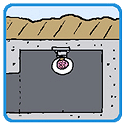|
SeanBeansShako posted:Well it is good to know if the balloon went up, half the city isn't going to burn and the casulties won't be horrible for the innocents. Actually the reason for moving the capital is only in part because of the DPRK. It's a major problem where Seoul is a giant magnet that sucks up all the young and talented people leaving an aged and uneducated countryside. A city full of unemployed young university graduates and a countryside that has to import farm workers from south asia. What is this "balloon"? Is it a metaphor or a real thing? THE LUMMOX fucked around with this message at 15:41 on May 9, 2012 |
|
|
|

|
| # ? Jun 10, 2024 05:15 |
THE LUMMOX posted:Actually the reason for moving the capitol is only in part because of the DPRK. It's a major problem where Seoul is a giant magnet that sucks up all the young and talented people leaving an aged and uneducated countryside. A city full of unemployed young university graduates and a countryside that has to import farm workers from south asia. So in other words, like London and the rest of the UK. Never heard of the term 'the balloon going up'? a bit old fashioned stereotypical WW1 Brit slang sort of thing I've gotten quite attached to using lately. Although the image of North Koreans getting really desperate and actually using balloon bombs is both comedic and horrifying realistic at the same time.
|
|
|
|
|
Most of the NK artillery is cold war stuff and older. Albeit old it's still soviet weapons, known for being made to last.
|
|
|
|
Gulf War 1 and 2 pretty comprehensively proved that the best, most experienced World War 1 army in the world is no match against even an inexperienced 21st Century army. The Iraqis have lots of experience with everything up to and including widespread use of gas, turns out none of that does you any good when the other side has B2s and F15s. The Americans and South Korean forces are much, much better at all kinds of things today than they were in 1991. Now many night vision devices do the North Koreans have per soldier? As soon as it turns dark your huge NK infantry columns who *can't see poo poo* are just going to be fish in a barrel to the Americans who can.
|
|
|
|
I dunno, how many flares can the spirit of Juche produce? Funny thing is that the RAF is moving to only precision munitions for their aircraft and other western air forces probably looking to do the same. Meanwhile I'd guess the USAF will never do away with dumb bomb stockpiles as long as there's a chance that they have to carpet bomb the gently caress out of 200kms of mountainous terrain. Same with mines btw.
|
|
|
|
Is real estate cheaper in the parts of Seoul within range of the NK border artillery? Because it should be.
|
|
|
|
Grand Prize Winner posted:Is real estate cheaper in the parts of Seoul within range of the NK border artillery? Because it should be. Is real estate anywhere in the world cheaper around strategic targets like Pentagon that are primary targets for ICBM's?
|
|
|
|
gradenko_2000 posted:I learned this from a Tom Clancy book, so forgive me if I'm horribly wrong, but it's not just about the number of warheads, but also the specific lay-out across the various delivery systems. I really dont think anyone should be quoting Tom Clancy for the purposes of real-life scenarios. This is the United States were talking about, we'll still have our nuclear triad of SLBMs, bombers, and ICBMs. Even if we dropped down to 600 weapons, and Russia as well, since its a mutual drawdown, thats still enough weapons to completely obliterate a hostile country and make the prospect of nuclear war not worth it. Russia isnt going to try to decapitate the US with a first strike, cause we'd still have enough weapons to utterly destroy them. Why do you think China only has a few hundred warheads? Cause thats enough of a deterrent.
|
|
|
|
SeanBeansShako posted:Although the image of North Koreans getting really desperate and actually using balloon bombs is both comedic and horrifying realistic at the same time. The Japanese beat them to it.
|
|
|
|
gradenko_2000 posted:The Japanese beat them to it. The Japanese were horribly late to the game.  But really the first time was as early as 1849, when Austrians were sieging Venice. And they were an instant hit: Venetian eye witness posted:The balloons appeared to rise to about 4,500 ft. Then they exploded in midair or fell into the water, or, blown by a sudden southeast wind, sped over the city and dropped on the besiegers. Venetians, abandoning their homes, crowded into the streets and squares to enjoy the strange spectacle. … When a cloud of smoke appeared in the air to make an explosion, all clapped and shouted. Applause was greatest when the balloons blew over the Austrian forces and exploded, and in such cases the Venetians added cries of ‘Bravo!’ and ‘Good appetite!’ quote:In the second attempt, on Aug. 22, the balloons, measuring 5.7 meters in diameter and using “charcoal and greasy cotton as a continuous combustion source,” were released from a “stable platform at sea,” according to the documentary. Venice surrendered soon after, though.
|
|
|
|
I've read that Livy wrote a book about how Alexander the Great and his army would fare against a Roman legion. I laughed and then remembered what WOULD happen if Alexander met Scipio Africanus, Alexander's cavalry would probably put Hannibal's to shame and it's charge was much more powerful, but on the other hand the phalanx never really had any success against the Legions. What do you guys think would happen?
|
|
|
|
Alchenar posted:I'm pretty sure all projections of a renewed Korean war have Seoul falling in the first few days. This was probably true as recently as the early 1990s, but in the past 20 years South Korean economic and military prowess have grown apace, while at the same time North Korea has almost totally collapsed. The KPA is too poor in money, food, and other supplies to maintain a high level of military readiness. Supply shortage mean reductions in training, lowering troop effectiveness. Equipment is obsolete, mostly vintage Soviet export models from the 1960s. Although the army gets preferential access to foodstuffs, the majority of soldiers are still malnourished. Apart from elite formations like their commandos and possibly their armored troops, the KPA has a very serious deficit in quality compared to the ROKA. In spite of being smaller on paper, it's likely that the ROKA actually has more combat effective formations than the KPA, which are also better trained and much better equipped than their potential opponents. Both sides of the DMZ are also very heavily fortified. A KPA offensive would be taking on superior troops, heavily entrenched in difficult terrain, while sustaining devastating air attacks. It would be a massacre. Also, even if their artillery matches what has been claimed (it almost certainly doesn't), it can't do the whole job for them. To support an advance, they would have to move guns forward from their camouflaged and fortified positions, exposing them to airpower. Even if they could use artillery to create a breakthrough in the initial line of defense (unlikely because of the minefields and dug-in fortifications on the ROK side of the DMZ), the South Koreans would meet it with mobile reserves. I'm repeating myself, but a fight between their T-62 and T-55 equipped spearheads and the South Korean K1s and K1A1s is an ugly prospect. Their artillery can wreck the northern part of the Seoul megalopolis and force a mass exodus of civilians, but that's not going to win a war.
|
|
|
|
Here's something I never knew until today. Did you know that the UK did their own version of Japan's "fire balloons"? They were drastically more effective in that at some point they started forest fires and also at another point struck a strategically significant target (a power station). They did however accidentally cause two Swedish trains to collide by severing the electrical lighting. Oops 
|
|
|
|
EvanSchenck posted:This was probably true as recently as the early 1990s, but in the past 20 years South Korean economic and military prowess have grown apace, while at the same time North Korea has almost totally collapsed. The KPA is too poor in money, food, and other supplies to maintain a high level of military readiness. Supply shortage mean reductions in training, lowering troop effectiveness. Equipment is obsolete, mostly vintage Soviet export models from the 1960s. Although the army gets preferential access to foodstuffs, the majority of soldiers are still malnourished. Apart from elite formations like their commandos and possibly their armored troops, the KPA has a very serious deficit in quality compared to the ROKA. The only problem with that is throughput: Can the smaller ROKA engage and destroy enough KPA units before it runs out of supplies? And do they have enough of their highly modern tanks to actually cover all major approaches? A UN company might be more combat capable than a KPA regiment, but that means little if the KPA has more regiments than the UN has companies (and a KPA soldier with a single magazine is still more capable than a UN soldier with a bayonet)
|
|
|
|
ArchangeI posted:The only problem with that is throughput: Can the smaller ROKA engage and destroy enough KPA units before it runs out of supplies? And do they have enough of their highly modern tanks to actually cover all major approaches? A UN company might be more combat capable than a KPA regiment, but that means little if the KPA has more regiments than the UN has companies (and a KPA soldier with a single magazine is still more capable than a UN soldier with a bayonet) I dunno, depending on how long that ammunition has been in storage I might put my money on the guy with the bayonet.
|
|
|
|
Considering that TFR regularly goes through crates of Soviet-era ammunition for turn-of-the-century guns, I think that a proper military shouldn't have any ptoblems.
|
|
|
|
Those munitions were also stored for the purpose of for profit resale, where as the NKA is mostly a empty husk of a show pony.
|
|
|
|
I don't think the Soviets stored them for resale. I'm no chemist, but it seems that ammunition lasts a while inside an airtight tin. The only problems they have with them is due to shoddy craftsmanship on the round itself.
|
|
|
|
Can we maybe please stop talking about Korean hypotheticals, as they have nothing to do with military history? Thank you.Ensign Expendable posted:I'm no chemist, but it seems that ammunition lasts a while inside an airtight tin. The only problems they have with them is due to shoddy craftsmanship on the round itself. Explosives are not stabile and will deteriorate over decades even under perfect storage conditions. This can mean that their yield drops, and on the other hand they may explode on their own or when moved just slightly. Otherwise some armies (*cough* FDF *cough*) would still be keeping WW2 Panzerfausts ready for the reserves. It would just be wasteful to throw them away if they still can knock out a BMP-1.
|
|
|
|
Have their been any wars other than the world wars that have produced so much leftover materiel? I mean, it seems to me that up till the late 70 a lot of armies (not necessarily first-rate armies, but armies still) were still using WWII leftover guns. Police forces and federales, too.
|
|
|
|
That's an unfair question because the part "have there been any was other than... that have produced so much materiel" already answers the question. There haven't been wars as large in scope, especially in the industrial sense, before or after. No other war could possible approach anything near that scale. All the materials wasted in the duration of the 100 years war could probably have been produced in a matter of a few months during WW2.
|
|
|
|
Grand Prize Winner posted:Have their been any wars other than the world wars that have produced so much leftover materiel? Are you counting the cold war as one of the world wars?
|
|
|
|
Grand Prize Winner posted:Have their been any wars other than the world wars that have produced so much leftover materiel? I mean, it seems to me that up till the late 70 a lot of armies (not necessarily first-rate armies, but armies still) were still using WWII leftover guns. Police forces and federales, too. The Spanish colonization (which was pretty much a war) left plenty of raw materials for them to use. You know, after killing everyone 
|
|
|
|
I vaguely remember something about Marius sending people around to collect weapons and armour from the old temples with which to arm new recruits after the disastrous first battles against the Cimbri, Teutones and Ambrones. Does that count?
|
|
|
|
Nenonen posted:Can we maybe please stop talking about Korean hypotheticals, as they have nothing to do with military history? Thank you. B-b-but... people are being wrong on the internet! Anyway, it's not strictly historical but I would say it's within the utility of the thread, because it helps explore concepts that are useful to a general understanding of modern warfare. I'll leave it alone, though.
|
|
|
|
Nenonen posted:That's an unfair question because the part "have there been any was other than... that have produced so much materiel" already answers the question. There haven't been wars as large in scope, especially in the industrial sense, before or after. No other war could possible approach anything near that scale. During WWII the US alone probably could have produced all of the weapons and material in all of the history of warfare prior to 1800 in just a few months.
|
|
|
|
EvanSchenck posted:B-b-but... people are being wrong on the internet! I know, I'm just trying to nudge the conversation back to things that I personally find more interesting.
|
|
|
|
Nenonen posted:Can we maybe please stop talking about Korean hypotheticals, as they have nothing to do with military history? Thank you. It's better than the WWII OSTRFRONT circlejerk that gets rehashed every 5 pages, and the situation on the Korean peninsula is basically living history. We talked about why Seoul won't get destroyed and I posted some (hopefully) interesting pictures that none of you have seen before. Anyway, I recently finished re-reading Right Hand of the Sun. It is historical fiction but lots of the events are documented in other places. It's a gripping read. Obviously colonialism was horrible but I'll be damned if Cortes' breakout from the Aztec capital on "The Sad Night" isn't a hell of a story. What are some other battles involving war canoes?
|
|
|
|
You're saying that the largest campaign in the history of warfare gets brought up a lot in the Military HIstory thread? That's strange.
|
|
|
|
Well obviously this is the place for WWII chat and I don't want to poo poo on anyone's interest but just trying to remind everyone that there are several thousand years of other important and incredibly interesting events in military history. But this is the marketplace of ideas and all that jazz. If goons want WWII then WWII it is. I don't want to poo poo up a good thread anymore than I already have.
|
|
|
|
Hey guys, have you heard about that bear? In WWII a Polish emigré brigade had a bear called Wojtek and he carried ammunition for them Seriously, though, let's talk animals in warfare. A lot of military formations have used an animal as a mascot, usually a dog or other domestic animal, but occasionally something like a tiger or bear cub. Just about any other animal that found its way into the military ended up being used as a draft or a cavalry animal. Camels, elephants, horses, donkeys, mules, and probably even dogs and alpacas have been used in a draft capacity, along with oxen. Of those, only camels, elephants, and horses saw use as battlefield critters. Why weren't the other ones used? My limited understanding is that generally they were either too slow, skittish, or small to ride, although there are those old Akkadian--I think-- carvings that feature onager-drawn battle-carts, sort of primitive chariots. Is this correct? Have I missed anything major? Aside from that we've got examples of animals used for communication, camp guarding, and mobile larders, with the primary examples being carrier pigeons, dogs, and goats, pigs, and cows respectively. I've heard that dogs have occasionally been used to sniff out mines, too. Am I forgetting any common tasks that animals were used for? I'm distinguishing 'common' from stuff like the firebomb-bats and pigeon-guided munitions the US developed during the war, or the bomb-dogs the russians tried. Actually wait, from those it seems like animal based munitions are actually A Thing. Have insurgents ever tried an animal bomb?
|
|
|
|
Well never underestimate the man eating Badger.
|
|
|
|
Grand Prize Winner posted:Am I forgetting any common tasks that animals were used for? I am remembering two warlike uses of the mighty Bat. The basic and most common was pooping. Guano was used as a source of chemicals for explosives (nitrates, if I recall correctly). But then there was apparently some sort experiment where bats had small incendiary bombs strapped to them, and then they were cooled down and loaded on an airplane to be dropped on some unsuspecting Japanese city, where, it was presumed, the bats would wake up, fly into nooks and crannies in buildings, chew the bomb off, and set the buildings on fire. I think this was not successful. (Actually, I just looked it up on wikipedia, where it is reported the Bat Bomb was "overtaken by the atomic bomb" which kind of makes bats pretty badass. http://en.wikipedia.org/wiki/Bat_bomb)
|
|
|
|
Mans posted:I've read that Livy wrote a book about how Alexander the Great and his army would fare against a Roman legion. I laughed and then remembered what WOULD happen if Alexander met Scipio Africanus, Alexander's cavalry would probably put Hannibal's to shame and it's charge was much more powerful, but on the other hand the phalanx never really had any success against the Legions. Depends what era of the legions you are talking about. It's Livy so I'm going with the legions at the height of their power vs Alexander at the height of his. Historically the legions beat up on every phalanx based army they fought. However all of the successor states had far less effective phalanxes then Alexander fielded. Alexanders troops could march and redeploy the phalanx far faster then any army before or after. This would be a tough nut for the Romans to crack, as their success were based off completely outmaneuvering their opponents. Also as you said the Companions would be a force to be reckoned with, considering they were a fast moving fast acting heavy cavalry elite. However the Roman legions at their height when Caesar and Agrippa were commanding them were the most dominant military force in the ancient world, bar none. Their infantry was the best trained and most well equipped in the world. They had allies and client states to provide cavalry, many from the same provinces Alexander once held. The Romans also used their Pila as anti-cavalry spears on more the one occasion, and combined with the discipline and cohesion, would be a challenge to the Companions as their strength was not charging massed organized infantry. The Romans fought off the Parthians successfully for hundreds of years, after learning from Crassus debacle at Carrahe, and they fields plenty of heavy cavalry. Basically if Caesar and Alexander were able to duke it out, it would comes down to generalship. Who could maneuver the other into fighting on ground unsuited for the other, and if the Romans could flank the phalanx. I'd say the edge goes to the Romans, since Alexander's army still has the gaping flaw that if the legionaries breached the phalanx, they were done. Basically there are more ways for Alexander to lose then for the Romans. The Romans have to avoid frontally assaulting the phalanx and keep the Compainions at bay. Alexander has to somehow fight off all he Roman cavalry, charge the legionaries and not lose his cavalry to the pila of the Romans, and make sure his phalanx never gets flanked, even though the Romans soldiers o nteh flank are just as good as the soldiers in the center.
|
|
|
|
Grand Prize Winner posted:Camels, elephants, horses, donkeys, mules, and probably even dogs and alpacas have been used in a draft capacity, along with oxen. Of those, only camels, elephants, and horses saw use as battlefield critters. Why weren't the other ones used? My limited understanding is that generally they were either too slow, skittish, or small to ride, although there are those old Akkadian--I think-- carvings that feature onager-drawn battle-carts, sort of primitive chariots. Is this correct? Have I missed anything major? Fun reindeer fact: a reindeer cannot pee while it's running, and if it's forced to ride without stopping to urinate for too long, it can become paralyzed. This has led to the Saami reindeer herders using 'piss of a reindeer' as a measure of distance, which is up to 7.5 km.  Swedes during their military heyday also considered taming elks (European moose) to be used for cavalry - the elk's large hoof enables it to run across deep snow more easily than horses, and their appetite is also easier to satisfy in the northern taiga because they eat anything that looks like a tree. But the plan didn't work at all. First of all it's nigh on impossible to tame an elk, they're just not wired that way. Even the tamed ones can snap at any moment. Secondly it would take a long time of selective breeding to make them as durable as a warhorse is. Fun moose fact: it's easy to ride on the back of a moose if you catch one swimming across a lake. Here's Teddy Roosevelt doing it: 
|
|
|
|
Is there anything that man didn't do?
|
|
|
|
Reach consensus about whether Hitler could've won the war or not.
|
|
|
|
Grand Prize Winner posted:Hey guys, have you heard about that bear? In WWII a Polish emigré brigade had a bear called Wojtek and he carried ammunition for them I always thought that this was pretty cool, for whatever reason : http://en.wikipedia.org/wiki/Timothy_%28tortoise%29 O, and this is pretty cool too : http://en.wikipedia.org/wiki/Blue_Peacock Didn't someone once use pigeons to guide torpedoes, or did I make that up?
|
|
|
|
Xiahou Dun posted:I always thought that this was pretty cool, for whatever reason : Bombs actually. They tried, but the project was scrapped because no one took it seriously. http://en.m.wikipedia.org/wiki/Project_Pigeon#_ It was mentioned in the post you quoted.
|
|
|
|

|
| # ? Jun 10, 2024 05:15 |
|
Digging through some old boxes the other month, I came across a few things that you guys might find somewhat interesting. It turns out that one of my great grandfathers was in WW1 in some capacity, and brought back a number of little pamphlets and books from the immediate aftermath of the war, and two of them in particular stood out: First one was essentially an FAQ on getting discharged from the army and what to expect upon coming home. What are your rights, where can you get help, and what the army can do for you along the way. It's interesting because it's the earliest example of a sort of "How to go back to a civilian life" guide I've ever seen, as well as a walkthrough on just how exactly a country disbands a conscript army. I managed to find a transcription of it thats pretty complete and worth a read: http://www.gjenvick.com/Military/WorldWarOne/Brochures/1919-WhereDoWeGoFromHere-TheRealDope.html. Unlike the next book, the writing style is very straightforward and earnest which seems uncommon for the era. The second I cant find a complete scan of and I'm terrified to try to put my copy in a scanner lest it split in half, but this one has the majority of it: For a New America in a New World written in 1919 for troops waiting to go back from France. quote:To the Soldiers and Sailors of the American Expeditionary Forces: You are going home after participating in some form in the most terrible war the earth has ever seen. What has it meant? What is it to mean? To you? To your country? To humanity? quote:"She built that apologetic first of all on her unspeakable arrogant view of the Germans as a super race so superlatively gifted that the world could afford to have the contribution of all other races blotted out of a 'Kultur' so transcendent as to make its dominance over the world the highest good of the whole human race. ... Anything that might be supposed to put this divine race in its proper place of world dominion was counted as thereby justified and sanctified." Interesting little things to check out if you've got a spare half hour. I'd love to see any other little pamphlets or booklets that were given out to the troops from the actual times things were happening, they give a much better insight into what people at the time actually knew and what their attitudes were about what had just happened than some armchair general nearly a hundred years after the fact.
|
|
|





























